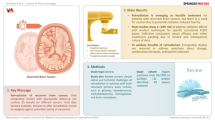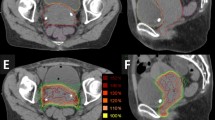Abstract
This paper summarizes outcomes of a single-center study of intracavitary brachytherapy (IBT) with stereotactically applied phosphorus-32 (32P) colloid for treatment of cystic craniopharyngiomas. We assessed its efficacy and safety, on the basis of clinical and radiological outcomes in one of the largest reported patient series. Between 1992 and 2011, 53 patients were treated with IBT, 14 without previous treatment and 39 who had previously been treated for recurrent cysts. Intervention was performed by applying 200 Gy to the internal cyst wall (median volume 6.1 ml). Median clinical and radiological follow-up were 60.2 and 53.0 months, respectively. Actuarial tumor cyst control was 86.0 ± 5.3 % at 12, 24, and 60 months. Actuarial out-of-field control (development of new cysts or progression of solid tumor parts) was 90.9 ± 4.3, 84.0 ± 5.6, and 54.5 ± 8.8 % after 12, 24, and 60 months, respectively. Corresponding actuarial overall progression-free survival was 79.4 ± 6.1, 72.4 ± 6.8, and 45.6 ± 8.7 % at 12, 24, and 60 months, respectively. Visual function improved for 12 patients (23.5 %), remained unchanged for 34 patients (66.7 %), and worsened for five patients (9.8 %), correlating with tumor progression in each case. Endocrinological deterioration occurred for ten patients (19.6 %); for nine patients this was a result of tumor progression or after tumor resection and for one it was attributed to irradiation. Within six months of IBT seven patients (13.7 %) experienced transient neurological deficits and two patients (3.9 %) deteriorated permanently (hemiparesis and third nerve palsy). Stereotactically applied 32P is highly efficacious for control of cystic components of craniopharyngiomas and is associated with a low risk of permanent morbidity. The procedure does not, however affect the development of new cysts or the progression of solid tumor parts.




Similar content being viewed by others
References
Karavitaki N, Cudlip S, Adams CB, Wass JA (2006) Craniopharyngiomas. Endocr Rev 27(4):371–397
Muller HL (2011) Consequences of craniopharyngioma surgery in children. J Clin Endocrinol Metab 96(7):1981–1991
Komotar RJ, Roguski M, Bruce JN (2009) Surgical management of craniopharyngiomas. J Neurooncol 92(3):283–296
Zuccaro G (2005) Radical resection of craniopharyngioma. Childs Nerv Syst 21(8–9):679–690
Kawamata T, Amano K, Aihara Y, Kubo O, Hori T (2010) Optimal treatment strategy for craniopharyngiomas based on long-term functional outcomes of recent and past treatment modalities. Neurosurg Rev 33(1):71–81
Marchal JC, Klein O, Thouvenot P, Bernier V, Moret C, Chastagner P (2005) Individualized treatment of craniopharyngioma in children: ways and means. Childs Nerv Syst 21(8–9):655–659
Thompson D, Phipps K, Hayward R (2005) Craniopharyngioma in childhood: our evidence-based approach to management. Childs Nerv Syst 21(8–9):660–668
Karavitaki N, Brufani C, Warner JT, Adams CB, Richards P, Ansorge O, Shine B, Turner HE, Wass JA (2005) Craniopharyngiomas in children and adults: systematic analysis of 121 cases with long-term follow-up. Clin Endocrinol (Oxf) 62(4):397–409
Choux M, Lena G, Genitori L (1991) Craniopharyngioma in children. Neurochirurgie 37(Suppl 1):1–174
Bunin GR, Surawicz TS, Witman PA, Preston-Martin S, Davis F, Bruner JM (1998) The descriptive epidemiology of craniopharyngioma. J Neurosurg 89(4):547–551
Kiehna EN, Merchant TE (2010) Radiation therapy for pediatric craniopharyngioma. Neurosurg Focus 28(4):E10
Yang I, Sughrue ME, Rutkowski MJ, Kaur R, Ivan ME, Aranda D, Barani IJ, Parsa AT (2010) Craniopharyngioma: a comparison of tumor control with various treatment strategies. Neurosurg Focus 28(4):E5
Sughrue ME, Yang I, Kane AJ, Fang S, Clark AJ, Aranda D, Barani IJ, Parsa AT (2011) Endocrinologic, neurologic, and visual morbidity after treatment for craniopharyngioma. J Neurooncol 101(3):463–476
Backlund EO (1994) Treatment of craniopharyngiomas: the multimodality approach. Pediatr Neurosurg 21(Suppl 1):82–89
Leksell L, Liden K (1952) A therapeutic trial with radioactive isotopes in cystic brain tumours. Radioisotope techniques. J Med Physiol Appl 4:1–4
Van den Berge JH, Blaauw G, Breeman WA, Rahmy A, Wijngaarde R (1992) Intracavitary brachytherapy of cystic craniopharyngiomas. J Neurosurg 77(4):545–550
Berenger N, Lebtahi R, Piketty M, Munari C, Merienne L, Turak B, Bok R, Askienazy S (1993) Endocavitary treatment of craniopharyngioma cysts by 186-rhenium [in French]. Médecine Nucléaire 17:120–128
Pollock BE, Lunsford LD, Kondziolka D, Levine G, Flickinger JC (1995) Phosphorus-32 intracavitary irradiation of cystic craniopharyngiomas: current technique and long-term results. Int J Radiat Oncol Biol Phys 33(2):437–446
Voges J, Sturm V, Lehrke R, Treuer H, Gauss C, Berthold F (1997) Cystic craniopharyngioma: long-term results after intracavitary irradiation with stereotactically applied colloidal beta-emitting radioactive sources. Neurosurgery 40(2):263–269; discussion 269–270
Hasegawa T, Kondziolka D, Hadjipanayis CG, Lunsford LD (2004) Management of cystic craniopharyngiomas with phosphorus-32 intracavitary irradiation. Neurosurgery 54(4):813–820; discussion 820–812
Julow J, Backlund EO, Lanyi F, Hajda M, Balint K, Nyary I, Szeifert GT (2007) Long-term results and late complications after intracavitary yttrium-90 colloid irradiation of recurrent cystic craniopharyngiomas. Neurosurgery 61(2):288–295; discussion 295–286
Derrey S, Blond S, Reyns N, Touzet G, Carpentier P, Gauthier H, Dhellemmes P (2008) Management of cystic craniopharyngiomas with stereotactic endocavitary irradiation using colloidal 186Re: a retrospective study of 48 consecutive patients. Neurosurgery 63(6):1045–1052; discussion 1052–1043
Blackburn TP, Doughty D, Plowman PN (1999) Stereotactic intracavitary therapy of recurrent cystic craniopharyngioma by instillation of 90yttrium. Br J Neurosurg 13(4):359–365
Janicki C, Seuntjens J (2003) Re-evaluation of the dose to the cyst wall in P-32 radiocolloid treatments of cystic brain tumors using the dose-point-kernel and Monte Carlo methods. Med Phys 30(9):2475–2481
Sturm V, Pastyr O, Schlegel W, Scharfenberg H, Zabel HJ, Netzeband G, Schabbert S, Berberich W (1983) Stereotactic computer tomography with a modified Riechert–Mundinger device as the basis for integrated stereotactic neuroradiological investigations. Acta Neurochir (Wien) 68(1–2):11–17
Treuer H, Klein D, Maarouf M, Lehrke R, Voges J, Sturm V (2005) Accuracy and conformity of stereotactically guided interstitial brain tumour therapy using I-125 seeds. Radiother Oncol 77(2):202–209
Strauss L, Sturm V, Georgi P, Schlegel W, Ostertag H, Clorius JH, van Kaick G (1982) Radioisotope therapy of cystic craniopharyngomas. Int J Radiat Oncol Biol Phys 8(9):1581–1585
Ende G, Treuer H, Boesecke R (1992) Optimization and evaluation of landmark-based image correlation. Phys Med Biol 37(1):261–271
Loevinger R (1954) The dosimetry of beta radiations. Radiology 62(1):74–82
Barriger RB, Chang A, Lo SS, Timmerman RD, DesRosiers C, Boaz JC, Fakiris AJ (2011) Phosphorus-32 therapy for cystic craniopharyngiomas. Radiother Oncol 98(2):207–212
Albright AL, Hadjipanayis CG, Lunsford LD, Kondziolka D, Pollack IF, Adelson PD (2005) Individualized treatment of pediatric craniopharyngiomas. Childs Nerv Syst 21(8–9):649–654
Samii M, Tatagiba M (1997) Surgical management of craniopharyngiomas: a review. Neurol Med Chir (Tokyo) 37(2):141–149
Fahlbusch R, Honegger J, Paulus W, Huk W, Buchfelder M (1999) Surgical treatment of craniopharyngiomas: experience with 168 patients. J Neurosurg 90(2):237–250
Van Effenterre R, Boch AL (2002) Craniopharyngioma in adults and children: a study of 122 surgical cases. J Neurosurg 97(1):3–11
Tomita T, Bowman RM (2005) Craniopharyngiomas in children: surgical experience at Children’s Memorial Hospital. Childs Nerv Syst 21(8–9):729–746
Steinbok P, Hukin J (2010) Intracystic treatments for craniopharyngioma. Neurosurg Focus 28(4):E13
Park DH, Park JY, Kim JH, Chung YG, Lee HK, Lee KC, Suh JK (2002) Outcome of postoperative intratumoral bleomycin injection for cystic craniopharyngioma. J Korean Med Sci 17(2):254–259
Hukin J, Steinbok P, Lafay-Cousin L, Hendson G, Strother D, Mercier C, Samson Y, Howes W, Bouffet E (2007) Intracystic bleomycin therapy for craniopharyngioma in children: the Canadian experience. Cancer 109(10):2124–2131
Mottolese C, Stan H, Hermier M, Berlier P, Convert J, Frappaz D, Lapras C (2001) Intracystic chemotherapy with bleomycin in the treatment of craniopharyngiomas. Childs Nerv Syst 17(12):724–730
Zanon N (1998) Craniopharyngiomas: intratumoral chemotherapy with bleomycin in children and adolescents. Arq Neuropsiquiatr 56:859
Linnert M, Gehl J (2009) Bleomycin treatment of brain tumors: an evaluation. Anticancer Drugs 20(3):157–164
Cavalheiro S, Dastoli PA, Silva NS, Toledo S, Lederman H, da Silva MC (2005) Use of interferon alpha in intratumoral chemotherapy for cystic craniopharyngioma. Childs Nerv Syst 21(8–9):719–724
Cavalheiro S, Di Rocco C, Valenzuela S, Dastoli PA, Tamburrini G, Massimi L, Nicacio JM, Faquini IV, Ierardi DF, Silva NS, Pettorini BL, Toledo SR (2010) Craniopharyngiomas: intratumoral chemotherapy with interferon-alpha: a multicenter preliminary study with 60 cases. Neurosurg Focus 28(4):E12
Dastoli PA, Nicacio JM, Silva NS, Capellano AM, Toledo SR, Ierardi D, Cavalheiro S (2011) Cystic craniopharyngioma: intratumoral chemotherapy with alpha interferon. Arq Neuropsiquiatr 69(1):50–55
Ierardi DF, Fernandes MJ, Silva IR, Thomazini-Gouveia J, Silva NS, Dastoli P, Toledo SR, Cavalheiro S (2007) Apoptosis in alpha interferon (IFN-alpha) intratumoral chemotherapy for cystic craniopharyngiomas. Childs Nerv Syst 23(9):1041–1046
Conflict of interest
The authors declare that they have no conflict of interest.
Author information
Authors and Affiliations
Corresponding author
Additional information
P. Kickingereder and M. Maarouf contributed equally to this study.
Rights and permissions
About this article
Cite this article
Kickingereder, P., Maarouf, M., El Majdoub, F. et al. Intracavitary brachytherapy using stereotactically applied phosphorus-32 colloid for treatment of cystic craniopharyngiomas in 53 patients. J Neurooncol 109, 365–374 (2012). https://doi.org/10.1007/s11060-012-0902-8
Received:
Accepted:
Published:
Issue Date:
DOI: https://doi.org/10.1007/s11060-012-0902-8




